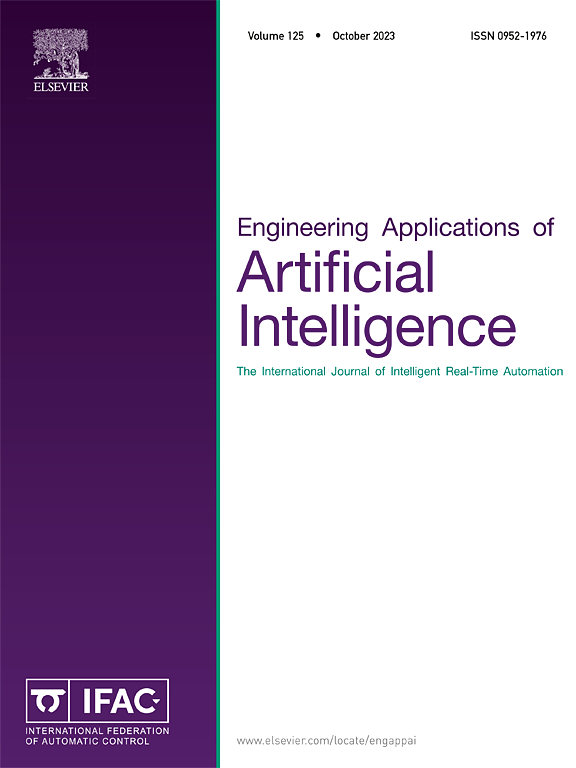使用雷达和可穿戴设备进行多乘员跟踪,以提高室内环境中的准确性
IF 7.5
2区 计算机科学
Q1 AUTOMATION & CONTROL SYSTEMS
Engineering Applications of Artificial Intelligence
Pub Date : 2025-05-02
DOI:10.1016/j.engappai.2025.110872
引用次数: 0
摘要
这项工作探讨了毫米波(mmWave)雷达和超宽带(UWB)设备的最小配置的集成,以增强在真实家庭环境中的多乘员跟踪。采用低成本、非侵入式和快速部署的设备设置,我们的方法解决了多乘员跟踪的关键挑战,包括个人识别和易于安装。虽然毫米波雷达可以精确地检测乘员的存在,但它缺乏个人识别能力,灵敏度有限。通过结合最小配置的超宽带(可穿戴标签和环境锚),可以通过信号强度测量实现个人识别,从而解决了这一限制。对长短期记忆(LSTMs)、卷积神经网络(CNN)或变压器等几种数据自编码器模型进行了评估。在两个真实的家庭环境中进行的实验,每个环境最多有三个居民,证明了将毫米波和超宽带技术结合起来进行室内多住户跟踪的有效性。结果表明,在单职业和多职业情况下,ConvLSTM的均方误差(MSE)分别在0,0142和0,0433之间,达到了最佳性能。这些发现表明,在环境辅助生活和其他智能环境背景下,有可能应用于精确的居民跟踪。本文章由计算机程序翻译,如有差异,请以英文原文为准。

Multi-occupant tracking with radar and wearable devices for enhanced accuracy in indoor environments
This work explores the integration of millimetre-wave (mmWave) radar and a minimal configuration of ultra-wideband (UWB) devices for enhanced multi-occupant tracking in real domestic environments. Using a low-cost, non-intrusive, and rapidly deployable device setup, our approach addresses key challenges in multi-occupant tracking, including individual identification and ease of installation. While mmWave radar precisely detects occupant presence, it lacks individual recognition and exhibits limited sensitivity. This limitations are addressed by incorporating a minimal configuration of UWB (wearable tags and ambient anchors), enabling individual identification through signal strength measurements. Several data autoencoder models, such as long short-term memories (LSTMs), Convolutional Neural Networks (CNN) or Transformers, were evaluated. Experiments conducted in two real-world domestic settings, each with up to three inhabitants, demonstrate the effectiveness of combining mmWave and UWB technologies for indoor multi-occupant tracking. Our results show that ConvLSTM achieves the best performance with a mean squared error (MSE) between 0,0142 and 0,0433 in single and multi-occupation, respectively. These findings suggest promising applications for accurate inhabitant tracking in ambient assisted living and other smart environment contexts.
求助全文
通过发布文献求助,成功后即可免费获取论文全文。
去求助
来源期刊

Engineering Applications of Artificial Intelligence
工程技术-工程:电子与电气
CiteScore
9.60
自引率
10.00%
发文量
505
审稿时长
68 days
期刊介绍:
Artificial Intelligence (AI) is pivotal in driving the fourth industrial revolution, witnessing remarkable advancements across various machine learning methodologies. AI techniques have become indispensable tools for practicing engineers, enabling them to tackle previously insurmountable challenges. Engineering Applications of Artificial Intelligence serves as a global platform for the swift dissemination of research elucidating the practical application of AI methods across all engineering disciplines. Submitted papers are expected to present novel aspects of AI utilized in real-world engineering applications, validated using publicly available datasets to ensure the replicability of research outcomes. Join us in exploring the transformative potential of AI in engineering.
 求助内容:
求助内容: 应助结果提醒方式:
应助结果提醒方式:


